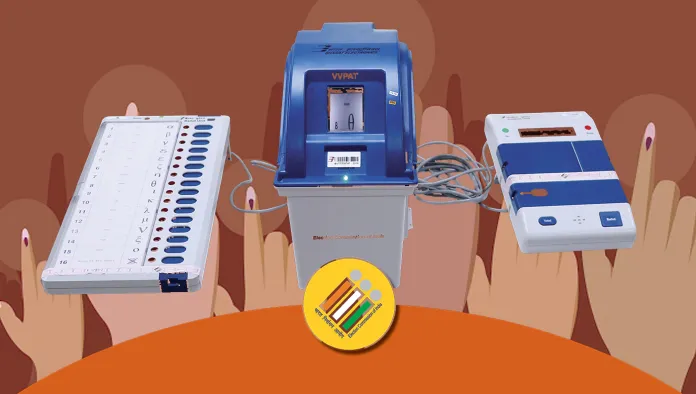Introduction: Evolution of the Indian Election Process

Elections are the cornerstone of democracy, enabling citizens to choose their representatives and shape the governance of their country. In India, the election process has undergone a significant transformation over the years. In the earlier days, elections were conducted using paper ballots, which were time-consuming, prone to errors, and vulnerable to manipulation. However, with the advent of technology, the introduction of Electronic Voting Machines (EVMs) has revolutionized the way elections are conducted, ensuring greater efficiency, transparency, and security.

The Technology Behind EVMs
Electronic Voting Machines (EVMs) are sophisticated devices designed to record votes electronically, eliminating the need for paper ballots. The technology behind EVMs can be broken down into several key components:
1. Control Unit (CU)
The Control Unit is the brain of the EVM, responsible for managing the entire voting process. It stores the data of the votes cast and is operated by the presiding officer. Key functions include:
- Vote Storage: Securely storing the votes in a tamper-proof manner.
- Results Display: Displaying the final vote count after the polling is closed.
- Security Features: Incorporating multiple security layers to prevent tampering and unauthorized access.
2. Ballot Unit (BU)
The Ballot Unit is the interface through which voters cast their votes. It consists of:
- Candidate Buttons: Each button corresponds to a candidate, allowing voters to select their preferred choice.
- Voter Verified Paper Audit Trail (VVPAT): A slip printer that provides a paper trail of the vote cast, enhancing transparency and voter confidence.
3. VVPAT (Voter Verifiable Paper Audit Trail)
Introduced to increase transparency, VVPAT allows voters to verify their vote. When a vote is cast, the VVPAT prints a slip containing the selected candidate’s name and symbol, which is visible to the voter through a transparent window before being stored in a sealed box.
4. Microcontroller and Firmware
EVMs are equipped with microcontrollers that run specific firmware designed to manage the voting process. This firmware ensures that each vote is recorded correctly and securely, and it includes various checks to detect and prevent tampering.
5. Security Measures
EVMs incorporate multiple security measures, such as:
- Tamper-Evident Seals: These seals ensure that any attempt to open the machine is easily detectable.
- Cryptographic Protection: Data within the EVMs is encrypted to prevent unauthorized access and ensure data integrity.
- Physical Security: EVMs are stored in secure locations and are subject to strict protocols during transportation and storage.

The Election Process in India
The election process in India is comprehensive and involves several stages to ensure free and fair elections. India successfully conducted World’s largest election ever with over 130+ Crore citizen this year till 4 June. Here’s a detailed look at the key stages:
1. Announcement and Notification
The election process begins with the Election Commission of India (ECI) announcing the election schedule, including the dates for polling and counting. This is followed by the official notification, marking the start of the electoral process.
2. Filing of Nominations
Candidates wishing to contest the elections file their nominations with the returning officer. The nominations are then scrutinized, and a final list of eligible candidates is published.
3. Election Campaigning
Candidates and political parties engage in election campaigning to promote their agendas and garner support from the electorate. Campaigning activities include rallies, public meetings, and media advertisements.
4. Polling Day
On the polling day, voters visit designated polling stations to cast their votes using EVMs. The polling process involves:
- Voter Identification: Voters are verified using voter ID cards or other acceptable identification documents.
- Casting the Vote: Voters press the button on the Ballot Unit corresponding to their chosen candidate. The VVPAT system provides an additional layer of verification.
5. Counting of Votes
After polling concludes, the EVMs are securely transported to counting centers. On the designated counting day, the votes stored in the Control Units are tallied, and the results are declared by the Election Commission.
6. Declaration of Results
The results are announced by the Election Commission, and the winning candidates are declared. This marks the conclusion of the election process, with successful candidates assuming their respective offices.
Conclusion: The Future of Elections in India
The integration of technology in the Indian election process, particularly through the use of EVMs, has significantly enhanced the efficiency, accuracy, and transparency of elections. As technology continues to evolve, further innovations such as blockchain-based voting systems and biometric authentication may be explored to address emerging challenges and strengthen the democratic process.
By understanding the technology behind EVMs and the detailed election process, we can appreciate the robust mechanisms in place to ensure that the world’s largest democracy conducts free, fair, and credible elections.

Leave a Reply